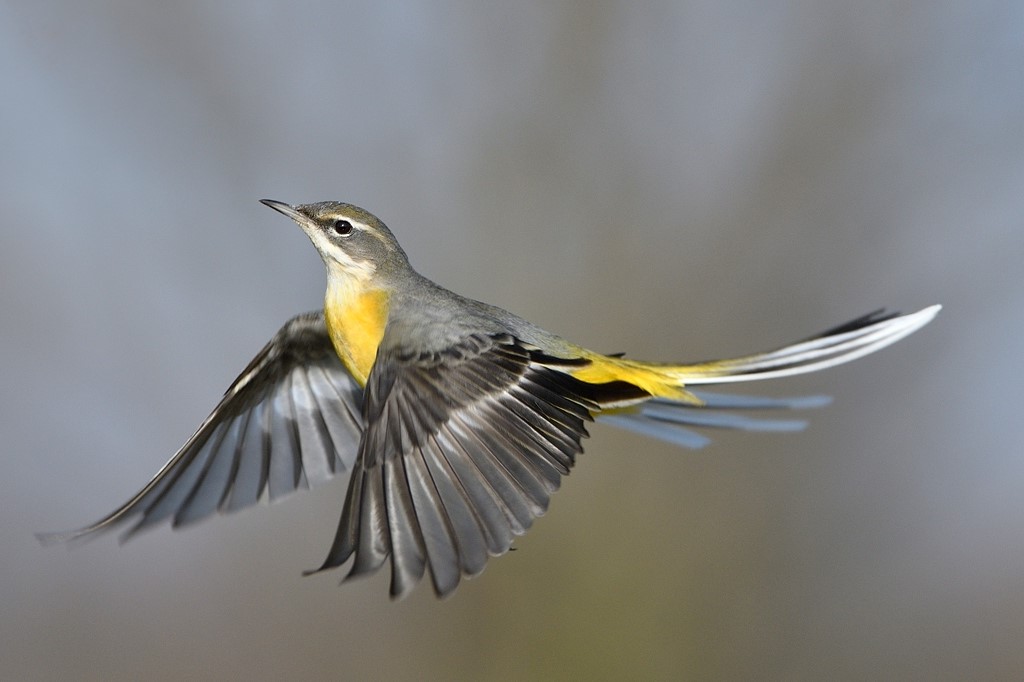The Grey Wagtail (Motacilla cinerea) is a small passerine bird belonging to the family Motacillidae. It is widely distributed across Europe and Asia, where it inhabits a variety of aquatic environments, including rivers, streams, and lakeshores. This article delves into the intriguing characteristics, behaviour, habitat, breeding, migration, conservation status, and more, shedding light on this captivating avian species.
Taxonomy and Physical Characteristics
The Grey Wagtail, scientifically known as Motacilla cinerea, is part of the Passeriformes order and the Motacillidae family. It is a slender bird, measuring around 18-19 centimetres in length, with a distinctive long tail that provides agility in flight. Its plumage is predominantly grey, with a vibrant yellow vent, belly, and breast, contrasting beautifully with its slate-grey upperparts. Males and females have similar appearances, although males may possess slightly brighter colouration during the breeding season. The Grey Wagtail’s bill is long and slender, well-suited for capturing small invertebrates in its aquatic habitat.

Distribution and Habitat
The Grey Wagtail has a vast distribution range, spanning across Europe and Asia. It can be found in countries such as the United Kingdom, France, Germany, China, India, and Japan. Within its range, the Grey Wagtail occupies a diverse array of aquatic habitats, including fast-flowing rivers, upland streams, lakeshores, and even urban areas with suitable water bodies. It demonstrates a preference for clear, clean water and is particularly fond of rocky habitats, where it can be seen perching on stones or shallow water edges. This adaptation to rocky habitats helps protect it from potential predators while providing easy access to its preferred diet of aquatic insects and invertebrates.
Behaviour and Diet
The Grey Wagtail is an active and agile bird, known for its constant tail wagging. This distinctive behaviour helps differentiate it from other wagtail species. It is also an adept flyer, capable of swift, darting flights over the water. The wagtail’s diet primarily consists of small invertebrates, including insects, larvae, and freshwater crustaceans. It forages along the water’s edge, frequently dipping its long bill into the water to capture its prey. The wagtail’s ability to feed in fast-flowing water sets it apart from other wagtails that prefer slower-moving or stagnant water bodies.
Breeding and Reproduction
Breeding season for the Grey Wagtail typically occurs from April to July. During this time, males engage in courtship displays, fluttering their wings and emitting a melodious song to attract females. The courtship displays also involve bowing movements and aerial chases. Nests are usually constructed in crevices, such as holes in riverbanks, walls, or bridges, providing protection and camouflage. The female Grey Wagtail takes the lead in nest-building, creating a cup-shaped structure using grass, moss, and leaves. The interior is carefully lined with soft materials like feathers or hair. A clutch consists of 4-6 eggs, which are incubated by the female for approximately 12-14 days. Both parents contribute to feeding the chicks until they fledge, which takes place around 15-18 days after hatching.
Migration
The Grey Wagtail is a partially migratory species. While some individuals are sedentary year-round, others undertake seasonal migrations. Populations breeding in colder regions of Europe and Asia migrate southward during the winter, seeking warmer climates with abundant food resources. These migratory wagtails can be spotted in countries such as Spain, Portugal, North Africa, and parts of South Asia. Migration patterns may vary among populations, with some undertaking long-distance journeys while others migrating shorter distances within their local regions.

Conservation Status and Threats
The Grey Wagtail is classified as a species of least concern on the IUCN Red List due to its wide distribution and stable population. However, several factors pose potential threats to its existence. Habitat degradation, pollution, and the alteration of river ecosystems can have detrimental effects on the wagtail’s breeding and foraging grounds. Water pollution from industrial and agricultural activities also negatively impacts its food sources. Climate change, with its associated shifts in temperature and rainfall patterns, may further disrupt the availability of suitable habitats. Conservation efforts, including the preservation and restoration of freshwater habitats, are crucial for ensuring the long-term survival of the Grey Wagtail. Additionally, raising awareness among local communities about the importance of clean water and habitat conservation can help mitigate threats to this remarkable species.
Interaction with Humans
The Grey Wagtail has adapted well to human-modified environments, often found in urban areas with suitable water bodies such as parks, gardens, and canal systems. Its charming appearance and lively behaviour make it a favourite among birdwatchers and nature enthusiasts. The wagtail’s presence along rivers and streams can also indicate the health of these aquatic ecosystems, making it an important indicator species. Citizen science projects and collaborative efforts between researchers and the public can contribute to monitoring Grey Wagtail populations and their habitat health.
Conclusion
The Grey Wagtail (Motacilla cinerea) is an enchanting avian species that thrives in a variety of aquatic habitats across Europe and Asia. With its distinctive plumage, active behaviour, and affinity for fast-flowing water, this small bird captures the attention and admiration of birdwatchers and nature lovers alike. While facing potential threats due to habitat degradation and pollution, concerted conservation efforts are crucial to ensure the Grey Wagtail’s continued survival and its role as an indicator of freshwater ecosystem health. By appreciating and protecting this remarkable species, we contribute to the preservation of biodiversity and the natural heritage of our planet.
Additional Resources
Sources and References
- Grey Wagtail – bto.org
- Svensson, L., Mullarney, K., & Zetterström, D. (2010). Collins Bird Guide: The Most Complete Guide to the Birds of Britain and Europe.
- Snow, D. W., & Perrins, C. M. (1998). The Birds of the Western Palearctic: Concise Edition.
Sam loves to learn about animals and their habitats. He has been a nature lover from a very young age, and has been writing papers and articles about wildlife for as long as he can remember.
